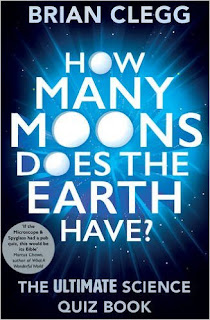B
Brian Clegg
Guest
I can't remember when I was last as excited about a new book coming out as I am about How Many Moons Does the Earth Have?, my science quiz book, which is available from today. And to make it even better, it was great fun to write.
One driver for this is that I enjoy pub quizzes, but I've always been disappointed with the quality and quantity of the science and technology questions. I think the thing that pushed me over the edge was taking part in a quiz which featured the question 'Who invented the gramophone?' According to the organisers, the answer was Thomas Edison, and despite my protests, they would not accept the correct answer. (It is, of course in the book.) So one thing this book does is provide two complete quizzes, each containing 6 traditional rounds with 8 questions each, plus two special rounds, one partly pictorial and the other with a sort of puzzle element, which can be used as table rounds. This means it can be run as a science quiz, or to provide science rounds to a general quiz.
However, realistically, 99% of readers are not going to run a quiz, so it's designed to be enjoyable to read through from end to end as well. Each of the 96 normal questions has the question, plus a few 'while you are thinking' factoids on one page and the answer, plus a page of explanation that expands on the answer, over the other side. And a reference to read more, if the topic grabs you. So you can test yourself, turn over and be surprised, then fascinated by what are inevitably the most weird, wonderful and unexpected answers I could find in all of science.
The other reason I'm delighted is that I think the publisher has done a great job with the book - the cover, which is textured, looks great, and it's priced to make it a really attractive stocking filler or just a 'Why not?' buy.
Okay, I'm biassed. But wouldn't you want to try out questions like these?
Obviously everything crossed! If it's the kind of thing that might interest you, you can see more at the book's web page.

One driver for this is that I enjoy pub quizzes, but I've always been disappointed with the quality and quantity of the science and technology questions. I think the thing that pushed me over the edge was taking part in a quiz which featured the question 'Who invented the gramophone?' According to the organisers, the answer was Thomas Edison, and despite my protests, they would not accept the correct answer. (It is, of course in the book.) So one thing this book does is provide two complete quizzes, each containing 6 traditional rounds with 8 questions each, plus two special rounds, one partly pictorial and the other with a sort of puzzle element, which can be used as table rounds. This means it can be run as a science quiz, or to provide science rounds to a general quiz.
However, realistically, 99% of readers are not going to run a quiz, so it's designed to be enjoyable to read through from end to end as well. Each of the 96 normal questions has the question, plus a few 'while you are thinking' factoids on one page and the answer, plus a page of explanation that expands on the answer, over the other side. And a reference to read more, if the topic grabs you. So you can test yourself, turn over and be surprised, then fascinated by what are inevitably the most weird, wonderful and unexpected answers I could find in all of science.
The other reason I'm delighted is that I think the publisher has done a great job with the book - the cover, which is textured, looks great, and it's priced to make it a really attractive stocking filler or just a 'Why not?' buy.
Okay, I'm biassed. But wouldn't you want to try out questions like these?
- If the Earth were made into a black hole, what would be the diameter of its event horizon?
- What links the elephant Tusko at Oklahoma City Zoo and Timothy Leary?
- If you too one step each second in seven-league boots, what would your speed be in miles per hour?
- What was Einstein’s 1930 patent for?
- Why did Uuq become Fl?
Obviously everything crossed! If it's the kind of thing that might interest you, you can see more at the book's web page.

